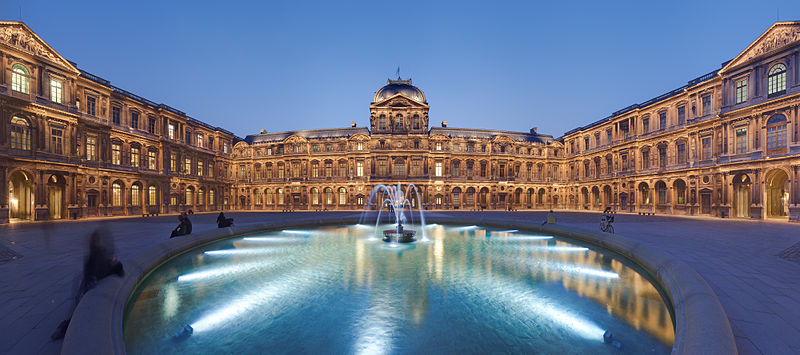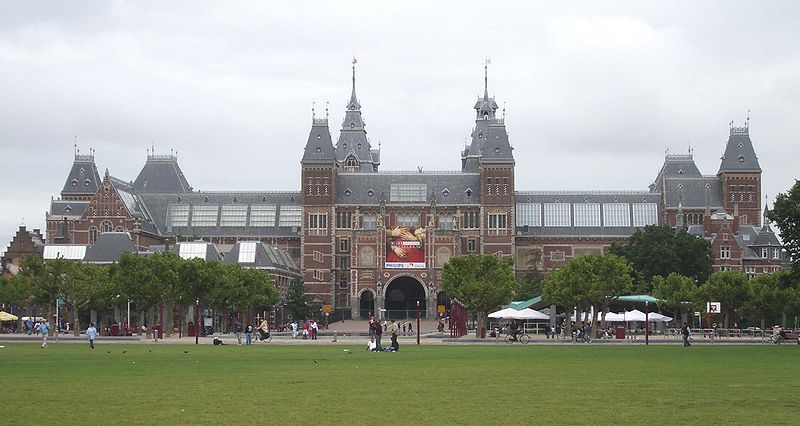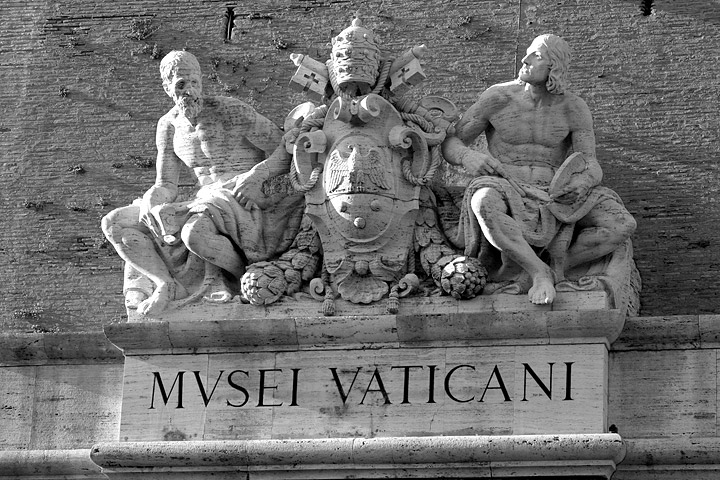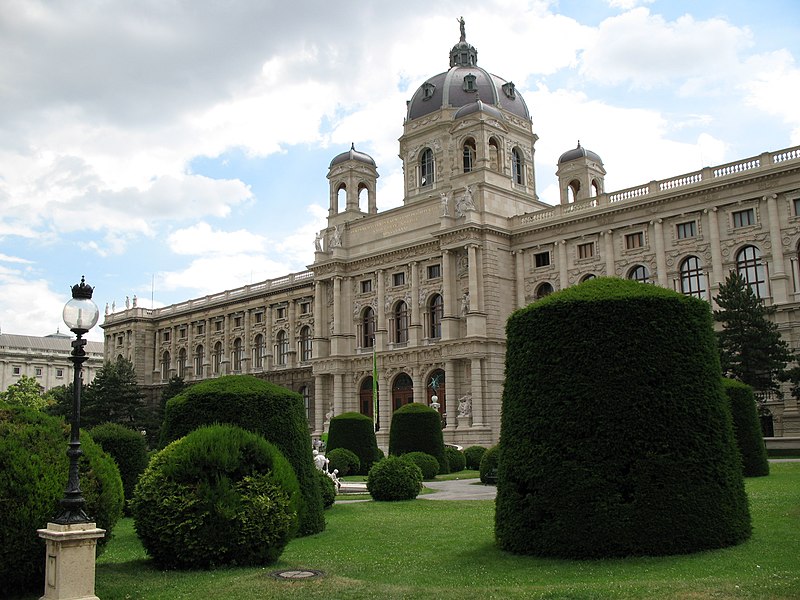10. Louvre – Paris (France)

Louvre, located in Paris, France, is one of the world’s largest palaces. It exemplifies traditional French architecture since the Renaissance, and it houses a magnificent collection of ancient and Western art. It is one of the most visited art museums in the world. The collection contains nearly 35,000 pieces displayed over the structure’s 60,000 square meters (650,000 sq ft). Louvre houses some of the world's most famous works of art, like Da Vinci's Mona Lisa; Jacques Louis David’s Oath of the Horatii; Delacroix’s Liberty Leading the People; and Alejandro of Antioch’s Venus de Milo.

Louvre, located in Paris, France, is one of the world’s largest palaces. It exemplifies traditional French architecture since the Renaissance, and it houses a magnificent collection of ancient and Western art. It is one of the most visited art museums in the world. The collection contains nearly 35,000 pieces displayed over the structure’s 60,000 square meters (650,000 sq ft). Louvre houses some of the world's most famous works of art, like Da Vinci's Mona Lisa; Jacques Louis David’s Oath of the Horatii; Delacroix’s Liberty Leading the People; and Alejandro of Antioch’s Venus de Milo.
9. The National Museum of Natural History – Washington D.C. (USA) 
The National Museum of Natural History is a museum administered by the Smithsonian Institution, located in Washington D.C. The museum’s collections total over 125 million specimens of plants, animals, fossils, minerals, rocks, meteorites, and human cultural artifacts. It is the second most popular of all of the Smithsonian museums and is also home to about 185 professional natural history scientist — the largest group of scientists dedicated to the study of the natural and cultural history in the world.

The National Museum of Natural History is a museum administered by the Smithsonian Institution, located in Washington D.C. The museum’s collections total over 125 million specimens of plants, animals, fossils, minerals, rocks, meteorites, and human cultural artifacts. It is the second most popular of all of the Smithsonian museums and is also home to about 185 professional natural history scientist — the largest group of scientists dedicated to the study of the natural and cultural history in the world.
8. The Palace Museum, Beijing (China) 
Located in the center of Beijing, the Palace Museum, historically and artistically one of the most comprehensive museums in China. It was established on the basis of the Forbidden City, a palace of the Ming and Qing dynasties (1368-1840), and their collection of treasures.

Located in the center of Beijing, the Palace Museum, historically and artistically one of the most comprehensive museums in China. It was established on the basis of the Forbidden City, a palace of the Ming and Qing dynasties (1368-1840), and their collection of treasures.
7. The Museo Del Prado – Madrid (Spain) 
The Prado Museum is renowned as being the largest art gallery in the world. It also exhibits sculptures, drawings, coins and other works of arts, but it is undoubtedly its large collection of paintings which has given it fame worldwide. It houses more than 8,600 paintings, of which they exhibit less than 2,000 because of lack of space available. Many museums throughout the world have less artistic riches in their halls than the Prado Museum has in storage.

The Prado Museum is renowned as being the largest art gallery in the world. It also exhibits sculptures, drawings, coins and other works of arts, but it is undoubtedly its large collection of paintings which has given it fame worldwide. It houses more than 8,600 paintings, of which they exhibit less than 2,000 because of lack of space available. Many museums throughout the world have less artistic riches in their halls than the Prado Museum has in storage.
6. Rijksmuseum Amsterdam (Netherlands) 
With close on one million objects, Amsterdam’s Rijksmuseum is the largest museum of art and history in the Netherlands. It is perhaps best known for its collection of 17th-century Dutch masters, with twenty Rembrandts and many other highlights of the period, including works by Vermeer, Frans Hals and Jan Steen.

With close on one million objects, Amsterdam’s Rijksmuseum is the largest museum of art and history in the Netherlands. It is perhaps best known for its collection of 17th-century Dutch masters, with twenty Rembrandts and many other highlights of the period, including works by Vermeer, Frans Hals and Jan Steen.
5. The Uffizi Gallery- Florence (Italy)

The Uffizi Gallery (Galleria degli Uffizi), one of the oldest and most famous art museums in the world, is housed in the Palazzo degli Uffizi, a palazzo in Florence, Italy. The collection of works in the Uffizi Gallery cannot be compared to any other world collection and is probably the only one to have just masterpieces of exceptional value.

The Uffizi Gallery (Galleria degli Uffizi), one of the oldest and most famous art museums in the world, is housed in the Palazzo degli Uffizi, a palazzo in Florence, Italy. The collection of works in the Uffizi Gallery cannot be compared to any other world collection and is probably the only one to have just masterpieces of exceptional value.
4. The Vatican Museum (Vatican)

The Vatican Museums are among the greatest museums in the world. They are the public art and sculpture museums in the Vatican City which display works from the extensive collection of the Roman Catholic Church. The Sistine Chapel and the Stanze Della Segnatura decorated by Raphael are on the visitor route through the Vatican Museums. They are continuously visited by millions of every year.

The Vatican Museums are among the greatest museums in the world. They are the public art and sculpture museums in the Vatican City which display works from the extensive collection of the Roman Catholic Church. The Sistine Chapel and the Stanze Della Segnatura decorated by Raphael are on the visitor route through the Vatican Museums. They are continuously visited by millions of every year.
3. The Hermitage St. Petersburg - Moscow (Russia)

Hermitage collections of works of art (over 3,000,000 items) present the development of the world culture and art from the Stone Age to the 20th century. With the possible exception of the Louvre, there is no museum in the world that rivals the Hermitage in size and quality. Its collection is so large that it would take years to view it in its entirety. The museum is especially strong in Italian Renaissance and French Impressionist paintings, as well as possessing outstanding collections of works by Rembrandt, Picasso, and Matisse. isitors should also take advantage of its excellent Greek and Roman antiquities collection and its exhibits of Siberian and Central Asian art. Not least among the attractions of the Hermitage is the museum itself, with its fine interior decoration and architectural detail.

Hermitage collections of works of art (over 3,000,000 items) present the development of the world culture and art from the Stone Age to the 20th century. With the possible exception of the Louvre, there is no museum in the world that rivals the Hermitage in size and quality. Its collection is so large that it would take years to view it in its entirety. The museum is especially strong in Italian Renaissance and French Impressionist paintings, as well as possessing outstanding collections of works by Rembrandt, Picasso, and Matisse. isitors should also take advantage of its excellent Greek and Roman antiquities collection and its exhibits of Siberian and Central Asian art. Not least among the attractions of the Hermitage is the museum itself, with its fine interior decoration and architectural detail.
2. The State Tretyakov Gallery – Moscow (Russia)

The State Tretyakov Gallery, Moscow, Russia, is the national treasury of Russian fine art and one of the greatest museums in the world. The Gallery's collection consists entirely of Russian art and artists who have made а contribution to the history of Russian art or been closely connected with it. The collection contains more than 130,000 works of painting, sculpture and graphics, created throughout the centuries by successive generations of Russian artists. Russian art works on display ranging in date from the 11th to the early 20th century.

The State Tretyakov Gallery, Moscow, Russia, is the national treasury of Russian fine art and one of the greatest museums in the world. The Gallery's collection consists entirely of Russian art and artists who have made а contribution to the history of Russian art or been closely connected with it. The collection contains more than 130,000 works of painting, sculpture and graphics, created throughout the centuries by successive generations of Russian artists. Russian art works on display ranging in date from the 11th to the early 20th century.
1. Kunsthistorisches Museum – Vienna (Austria)

The Kunsthistorisches Museum (English: “Museum of Art History”) in Vienna, is one of the premier museums of fine arts and decorative arts in the world. The term Kunsthistorisches Museum applies to both the institution and the main building. The building is rectangular in shape, and topped with a dome that is 60 meters high. The inside of the building is lavishly decorated with marble, stucco ornamentations, gold-leaf, and paintings, making it a spectacular work of art in its own right.

The Kunsthistorisches Museum (English: “Museum of Art History”) in Vienna, is one of the premier museums of fine arts and decorative arts in the world. The term Kunsthistorisches Museum applies to both the institution and the main building. The building is rectangular in shape, and topped with a dome that is 60 meters high. The inside of the building is lavishly decorated with marble, stucco ornamentations, gold-leaf, and paintings, making it a spectacular work of art in its own right.

No comments:
Post a Comment